Information System Development and Database Development
In many organizations, database development from the beginning of enterprise
data modeling, data modeling enterprises determine the scope of the database and the
general content. This step usually occurs in an organization's information system
planning process, it aims to help organizations create an overall data description or
explanation, and not the design of a specific database. A specific database for one or
more information systems provide data and the corporate data model (which may
involve a number of databases) described by the organization maintaining the scope
of the data. Data modeling in the enterprise, you review of the current system, the
need to support analysis of the nature of the business areas, the need for further
description of the abstract data, and planning one or more database development
project.
1.1 Information System Architecture
Senior data model is only general information system architecture (ISA) or a
part of an organization's information system blueprint. In the information system
planning, you can build an enterprise data model as a whole information system
architecture part. According to Zachman (1987), Sowa and Zachman (1992) views of
an information system architecture consists of the following six key components:
●Data
●Manipulation of data processing
●Networks, which organizations and in organizations with its main transmission of
data between business partners
●People who deal with the implementation of data and information and is the
source and ●receiver Implementation of the events and time points (they can use
state transition diagram ●and other means.)
The reasons for the incident and data processing rules (often in the form of text
display, but there are also a number of charts for the planning tools such as decision
tables).
developed
information
system architecture.
1.2 Information Engineering
Information systems planners in accordance with the specific information system
Information
planning methods
engineering is a popular and formal methods.
Information engineering is a
data-oriented creation and maintenance of the information system. Information
engineering is because the data-oriented, so when you begin to understand how the
database is defined by the logo and when information engineering a concise
explanation is very helpful. Information Engineering follow top-down planning
approach, in which specific information systems from a wide range of information
needs in the understanding derived from (for example, we need about customers,
products, suppliers, sales and processing of the data center), rather than merging many
detailed information requested ( orders such as a screen or in accordance with the
importation of geographical sales summary report). Top-down planning will enable
developers to plan more comprehensive information system, consider system
components provide an integrated approach to enhance the information system and
the relationship between the business objectives of the understanding, deepen their
understanding of information systems throughout the organization in understanding
�
the impact.
Information Engineering includes four steps: planning, analysis, design and
implementation. The planning stage of project information generated information
system architecture, including enterprise data model.
1.3 Information System Planning
Information systems planning objective is to enable IT organizations and the
business strategy closely integrated, such integration for the information systems and
technology to make the most of the investment interest is very important. As the table
as a description, information engineering approach the planning stage include three
steps, we in the follow-up of three sections they discussed.
1. Critical factors determining the planning
Planning is the key factor that organizational objectives, critical success factors and
problem areas. These factors determine the purpose of the establishment of planning
and environment planning and information systems linked to strategic business
planning.
2. The planning organizations set targets
Organizations planning targets defined scope of business, and business scope will
limit the subsequent analysis and information systems may change places. Five key
planning targets as follows:
● organizational units in the various sectors.
● organizations location of the place of business operations.
● functions of the business support organizations handling mission of the relevant
group. Unlike business organizations function modules, in fact a function can be
assigned to various organizations modules (for example, product development
function is the production and sale of the common responsibility of the Ministry).
● types of entities managed by the organization on the people, places and things
● Information System data set processing software applications and support
of the major types of data.
procedures.
3. To set up a business model
A comprehensive business model
including the functions of each enterprise
functional decomposition model, the enterprise data model and the various planning
matrix. Functional decomposition is the function of the organization for a more
detailed decomposition process,
the functional decomposition is to simplify the
analysis of the issue, distracted and identify components and the use of the classical
approach.
The use of specific enterprise data model to describe the symbol. Apart from the
graphical description of this type of entity, a complete enterprise data model should
also include a description of each entity type description of business operations and a
summary of that business rules. Business rules determine the validity of the data.
An enterprise data model includes not only the types of entities, including the link
between the data entities, as well as various other objects planning links. Showed that
the linkage between planning targets a common form of matrix. Because of planning
matrix need not be explicit modeling database can be clearly described business needs,
planning matrix is an important function. Regular planning matrix derived from the
�
operational rules, it will help social development activities that top priority will be
sorting and development
top-down view through an
enterprise-wide approach for the development of these activities. There are many
types of planning matrix is available, their commonalities are:
activities under
the
● locations - features show business function in which the implementation of
● unit - functions which showed that business function or business unit
operational locations.
responsible for implementation.
● Information System - data entities to explain how each information system
interact with each data entity (for example, whether or not each system in each entity
have the data to create, retrieve, update and delete).
● support functions - data in each functional entities in the data set for the
acquisition, use, update and delete.
business objectives.
● Information System - target indication for each information system to support
Figure 3 illustrate a possible functions - data entities matrix. Such a matrix can be
used for a variety of purposes, including the following three objectives:
1) identify gaps in the data entities to indicate the types of entities not use any
function or functions which do not use any entity.
2) found that the loss of each functional entities involved in the inspection staff
through the matrix to identify any possible loss of the entity.
3) The distinction between development activities if the priority to the top of a
important
system development function for a high-priority (probably because it
organizational objectives related), then this area used by entities in the development
of the database has a high priority.
Hoffer, George and Valacich (2002) are the works of the matrix on how to use the
planning and completion of the Information Engineering
The planning system more complete description.
2 database development process
Based on information engineering information systems planning database is a
source of development projects. These new database development projects is usually
in order to meet the strategic needs of organizations, such as improving customer
support,
improve product and inventory management, or a more accurate sales
forecast. However, many more database development project
is the bottom-up
approach emerging, such as information system user needs specific information to
complete their work, thus beginning a project request, and as other information
systems experts found that organizations need to improve data management and begin
new projects. Bottom-up even in the circumstances, to set up an enterprise data model
is also necessary to understand the existing database can provide the necessary data,
otherwise, the new database, data entities and attributes can be added to the current
data resources to the organization.
Both the strategic needs or operational
information needs of each database
development projects normally concentrated in a database. Some projects only
concentrated in the database definition, design and implementation of a database, as a
follow-up to the basis of the development of information systems. However, in most
�
cases, the database and associated information processing function as a complete
information systems development project was part of the development.
2.1 System Development Life Cycle
Guide management information system development projects is the traditional
process of system development life cycle (SDLC). System development life cycle is
an organization of the database designers and programmers information system
composed of the Panel of Experts detailed description, development, maintenance and
replacement of the entire information system steps. This process is because Waterfall
than for every step into the adjacent the next step, that is, the information system is a
specification developed by a piece of land, every piece of the output is under an input.
However shown in the figure, these steps are not purely linear, each of the steps
overlap in time (and thus can manage parallel steps), but when the need to reconsider
previous decisions, but also to roll back some steps ahead. (And therefore water can
be put back in the waterfall!)
Enterprise Modeling
Database development process from the enterprise modeling (system development
life cycle stage of the project feasibility studies, and to choose a part), Organizations
the scope and general database content. Enterprise modeling in information
set
systems planning and other activities,
these activities determine which part of
information systems need to change and strengthen the entire organization and
outlines the scope of data. In this step, check the current database and information
systems, development of the project as the main areas of the nature of the business,
with a very general description of each term in the development of information
systems when needed data. Each item only when it achieved the expected goals of
organizations can be when the next step.
Conceptual Data Modeling
One has already begun on the Information System project, the concept of data
modeling phase of the information systems needs of all the data. It is divided into two
stages. First, it began the project in the planning stage. At the same time outlining the
establishment of other documents to the existing database without considering the
circumstances specific development projects in the scope of the required data. This
category only includes high-level data (entities), and main contact. Then in the system
development life-cycle analysis stage must have a management information system
set the entire organization Details of the data model definition of all data attributes,
listing all data types that all data inter-entity business linkages, defining description of
the full data integrity rules. In the analysis phase, but also the concept of inspection
data model (also called the concept behind the model) and the goal of information
systems used to explain other aspects of the model of consistency categories, such as
processing steps, rules and data processing time of timing. However, even if the
concept
is only preliminary, because follow-up
information system life cycle activities in the design of services, statements, display
and inquiries may find that missing element or mistakes. Therefore, the concept of
data often said that modeling is a top-down manner, its areas of operation from the
general understanding of the driver, rather than the specific information processing
activities by the driver.
is such detailed data model
Database Implementation
�
The database prepared by the realization stage, testing and installation procedures
for handling databases. Designers can use the standard programming language (such
as COBOL, C or Visual Basic), the dedicated database processing languages (such as
SQL), or the process of the non-exclusive language programming in order to produce
a statement of the fixed format, the result will be displayed, and may also include
charts. In achieving stage, but also the completion of all the database files, training
users for information systems (database) user setup program. The final step is to use
existing sources of information (documents legacy applications and databases and
now needs new data) loading data. Loading data is often the first step in data from
existing files and databases to an intermediate format (such as binary or text files) and
then to turn intermediate loading data to a new database. Finally, running databases
and related applications for the actual user maintenance and retrieval of data. In
operation, the regular backup database and the database when damaged or affected
resume database.
Database maintenance
During the database in the progressive development of database maintenance. In
this step, in order to meet changing business conditions, in order to correct the
erroneous database design, database applications or processing speed increase, delete
or change the structure of the database. When a procedure or failure of the computer
database affect or damage the database may also be reconstruction. This step usually
is the longest in the database development process step, as it continued to databases
and related applications throughout the life cycle, the development of each database
can be seen as a brief database development process and data modeling concepts arise,
logical and physical database design and database to achieve dealing with the
changes.
2.2 Information System developed by other means
System Development Life Cycle minor changes in law or its variant of the often
used to guide information systems and database development. Information System is a
life-cycle methodology, it is highly structured approach, which includes many checks
and balances to ensure that every step of produce accurate results, and new or
alternative information system and it must communications or data definitions
consistent existing system needs consistency. System development life cycle because
of the regular need to have a working system for a long time been criticized because
only work in the system until the end of the whole process generated. More and more
organizations now use rapid application development method, it is a includes analysis,
design and implementation of steps to repeat
the rapid iterative process until
convergence to users the system so far. Rapid Application Development Act required
the database has been in existence, and enhance system is mainly to the application of
data retrieval application, but not
to those who generate and modify database
applications.
The most widely used method of rapid application development is one of the
prototype. The prototype system is a method of iterative development process,
analysts and users through close co-operation, continuing to revise the system will
eventually convert all the needs of a working system. Figure 6 shows prototype of the
process. In this diagram we contains notes, briefly describes each stage of the
prototype of
the database development activities. Normally, when information
�
systems problems were identified, tried only a rough concept of data modeling. In the
development of the initial prototype, the design of the user wants to display and
statements, and that any new database needs and define a term prototype database.
This is usually a new database, copy the part of the existing system, but might also
added some new content. When the need for new content, these elements are usually
from external data sources, such as market research data, the general economic
indicators or industry standards.
When a prototype of a new version to repeat the achievement and maintenance of
database activities. Usually only a minimum level of security and integrity control,
because at this time the focus is as soon as possible to produce a prototype version can
be used. But document management project also deferred to the final, only be used in
the delivery of user training. Finally, once constructed an acceptable prototype,
developers, and users will be the final decision of whether to prototype delivery and
the use of the database. If the system (including database) efficiency is very low, then
the system and database will be re-programming and re-organization in order to
achieve the desired performance.
Along with visual programming tools (such as Visual Basic, Java, Visual C + + and
fourth generation language) increasingly popular use of visual programming tools can
easily change the user interface with the system, the prototype is becoming the choice
of system development methodology. Customers using the prototype method
statements and show changes to the content and layout is quite easy. In the process,
the new database needs were identified, so it is the development of the use of the
existing database should be amended. There is even the possibility of a need for a new
database system prototype method, in such circumstances, when the system demand
in the iterative process of development in the ever-changing needs access to sample
data, the construction or reconstruction of the database prototype.
3 database development of the three-tier architecture model
In this article on the front of the database development process mentioned in the
interpretation of a system development project on the establishment of the several
different, but related database view or model:
● conceptual model (in the analysis stage of the establishment).
● external model or user view (in the analysis phase and the establishment of
● physical model or internal model (in the physical design phase of the
logical design phase).
establishment).
Figure 7 describes the database view that the relationship between the three, it is
important to remember that they are the same organizations database view or model.
In other words, each organization has a database of the physical model, a concept
model and one or more users view. Therefore, the three-tier architecture model using
the same data set observe the different ways definition database.
Concept models on the full database structure, has nothing to do with the technical
specifications. Conceptual model definition do not involve the entire database data
stored in the computer how the secondary memory. Usually, the conceptual model by
entities - links (E-R) map or object modeling symbols such a graphical format to
describe, we have this type of concept model called the data model. In addition, the
conceptual model specification as a metadata stored in the database or data dictionary.
�
Physical models including conceptual model of how data stored in computer
memory in the two specifications. Analysts and the database design is as important to
the physical database (physical mode) definition, it provides information on the
distribution and management of data storage and access of the physical memory space
of two full database technology specifications.
Database development and database technology database is among the three models
divided into basis. Database development projects may have a role to only deal with
these three views of a related work. For example, a beginner may be designed for one
or more procedures external model, and an experienced developer will design the
physical model or conceptual model. Database design issues at different levels are
quite different.
信息系统开发和数据库开发
在许多组织中,数据库开发开始于企业数据建模,企业数据建模确定了数据
库的范围和一般内容。这一步通常发生在一个组织的信息系统规划过程中,它的
目的是帮助企业创建一个整体的数据说明和解释,并没有一个特定的数据库的设
计。一个特定的数据库中的一个或多个信息系统提供的数据和公司数据模型(可
能会涉及多个数据库)所描述的组织保持的数据的范围。数据在企业建模中,可
以查看当前的系统,需要支持的业务领域,需要进一步说明的抽象数据,一个或
多个数据库的开发项目和规划的性质分析。
1.1 信息系统架构
高级数据模型只是一般的信息系统架构(ISA)或一个组织的信息系统蓝图
的一部分。在信息系统的规划中,你可以建立一个企业数据模型作为一个整体的
信息系统架构的一部分。据 Zachman(1987 年) ,Sowa 和 Zachman (1992)
的观点,信息系统架构的意见包括以下六个关键组件:
●数据
●操纵的数据处理
●网络,组织和在组织中,其主要贸易伙伴之间的数据传输。
●人们处理数据和信息实施是信号源和接收机
●执行的事件和时间点
●事件和数据的处理规则的原因。
1.2 信息工程
信息系统规划人员根据特定的信息系统规划方法开发的信息系统架构。信息
工程是一个流行和正式的方法。信息工程是一个面向数据的创建和维护的信息系
统。信息化工程是,因为面向数据的,所以当你开始了解数据库是如何定义的标
志和信息工程的简要说明是非常有用的。信息工程遵循自上而下的规划方法,即
从一个广泛的信息需求的理解来自特定的信息系统(例如,我们需要对客户,产
品,供应商,销售和处理数据中心的),而不是合并许多要求的详细信息(订单
如屏幕或按照进口地区销售总结报告) 。自上而下的规划将使开发人员能够更
全面的信息系统计划,考虑系统组件提供了一个综合性的方法来提高信息系统和
业务目标之间的关系的理解,加深对信息系统的理解的影响在整个组织。
信息工程包括四个步骤:规划,分析,设计和实施。在规划阶段,项目产生
的信息的信息系统架构,包括企业数据模型。
1.3 信息系统规划
信息系统规划目标是使 IT 组织和业务战略紧密结合起来,这种整合的信息
�
系统和技术,使大部分的投资权益是非常重要的。如上表描述,信息工程方法在
规划阶段包括三个步骤,我们在后续三个部分,他们讨论。
1。确定规划的关键因素
规划,组织目标的关键因素,关键成功因素和问题领域。这些因素决定了规
划和环境规划与企业战略规划和信息系统的建立目的。
2。策划组织设定目标
组织规划目标确定的业务范围,业务范围将限制后续的分析和信息系统可能
会改变的地方。五重点规划指标如下:
●在各部门的组织单位。
●组织,经营地点的位置。
●功能的业务支撑机构处理有关集团的使命。与商业机构不同的功能模块,
实际上是一个功能可以被分配到各个组织模块(例如,产品开发功能是生产和销
售部的共同责任)
●由该组织的主要类型的数据对人,地点和事物管理的实体类型
●信息系统的数据处理软件,应用程序和支持程序。
3。要建立一个商业模式
一个全面的业务模式,包括每个企业的功能分解模型,企业数据模型和各
种规划矩阵的功能。功能分解的更详细的分解过程中的组织的功能,功能分解是
为了简化分析这一问题,心烦意乱和拣选组件和使用的经典方法。
使用特定的企业数据模型描述符号。除了从图形描述这种类型的实体,一个
完整的企业数据模型还应该包括每个实体类型描述的业务营运及业务规则的总
结说明。业务规则确定的数据的有效性。
企业数据模型不仅包括类型的实体,包括数据实体之间的链路,以及其他
各种对象的规划链接。规划之间的联系,针对常见的矩阵形式。由于规划的矩阵
需要不明确的模型数据库,可以清楚地描述业务需求,规划矩阵是一个重要的功
能。定期规划矩阵来自操作规则,这将有助于社会发展活动的重中之重将被排序
和开发活动下的俯视图,通过这些活动的发展一个企业范围的方法。有许多类型
的规划矩阵可用,它们的共同点是:
●位置 - 业务功能功能显示在其中执行操作的位置。
●单元 - 这表明业务功能或业务单元负责执行的功能。
●信息系统 - 数据实体来解释每个信息系统如何与每个数据实体(例如,是
否每个系统各实体的数据创建,检索,更新和删除) 。
●支持功能 - 为收购设置在数据中各功能实体的数据,使用,更新和删除。
●信息系统 - 为每个信息系统,以支持业务目标的目标指示。
图 3 说明了一个可能的功能 - 数据实体矩阵。这样一个矩阵,可用于各
种各样的目的,包括以下三个目标:
1 )找出差距在数据实体来表示的实体类型不使用任何功能或功能不使用
任何实体。
2 )发现,通过矩阵的检验人员参与各功能实体的损失,以确定该实体的
任何可能发生的损失。
3)开发活动之间的区别,如果优先级高优先级的系统开发功能(可能是
因为它的重要的组织目标相关)的顶部,那么这个地区所使用的数据库实体的发
展,具有较高的优先级。 奥费,乔治和 Valacich 的(2002 年)的作品是如何使
用信息工程的规划和完成的矩阵
�
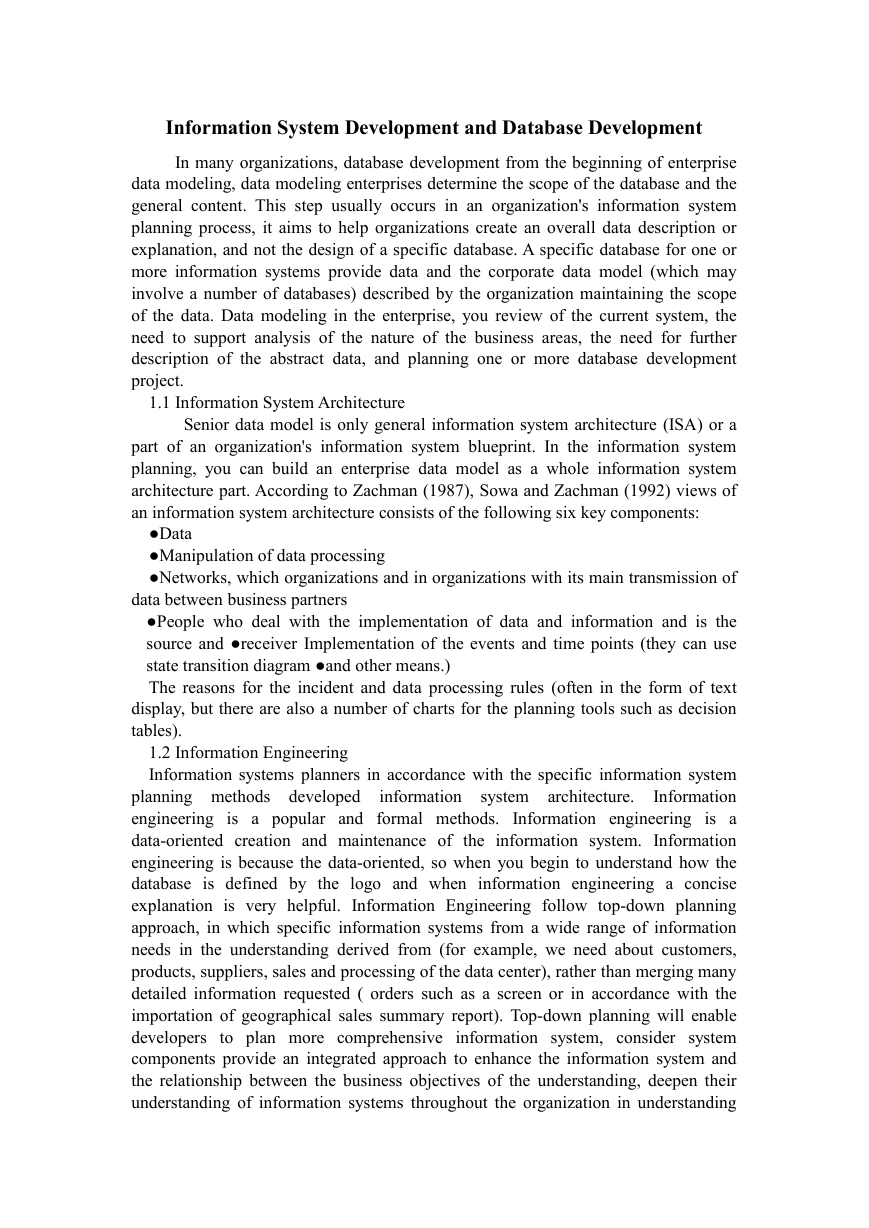
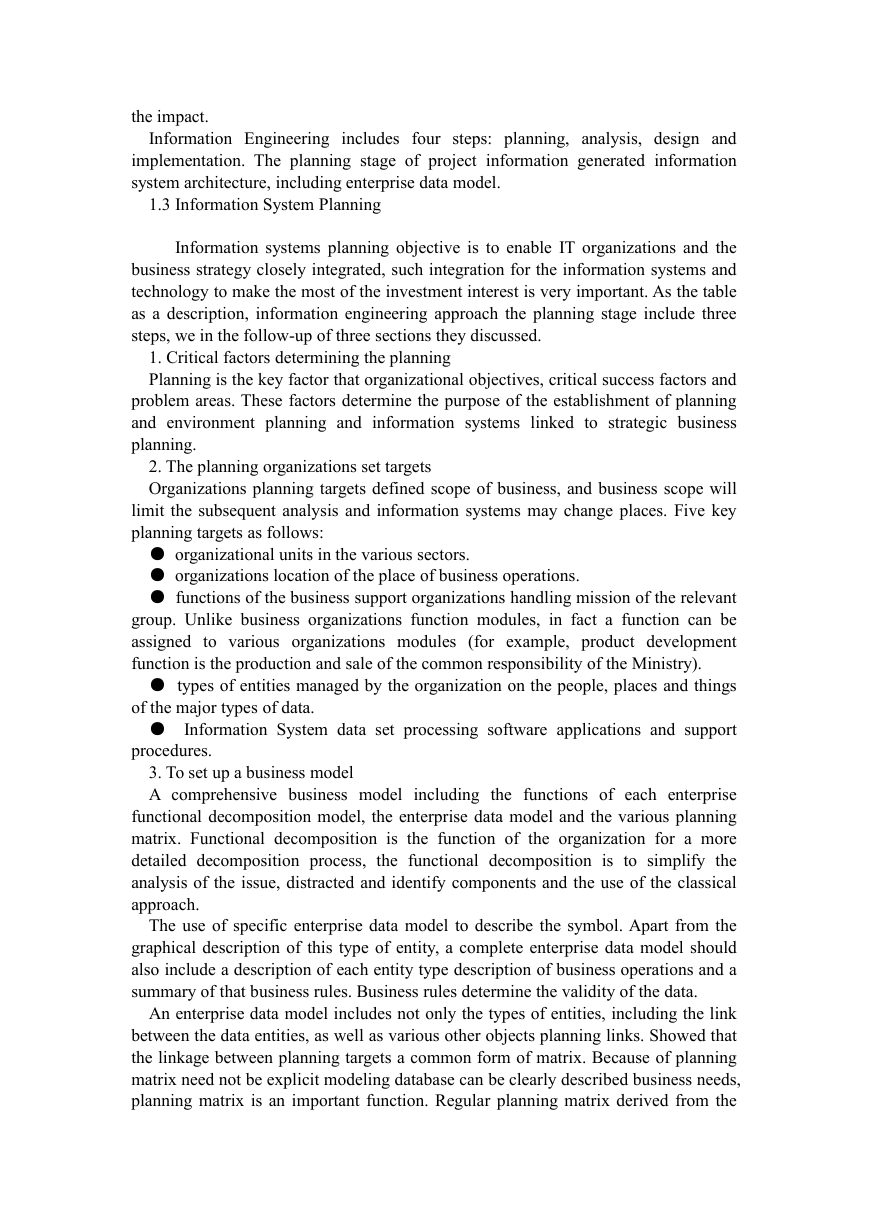
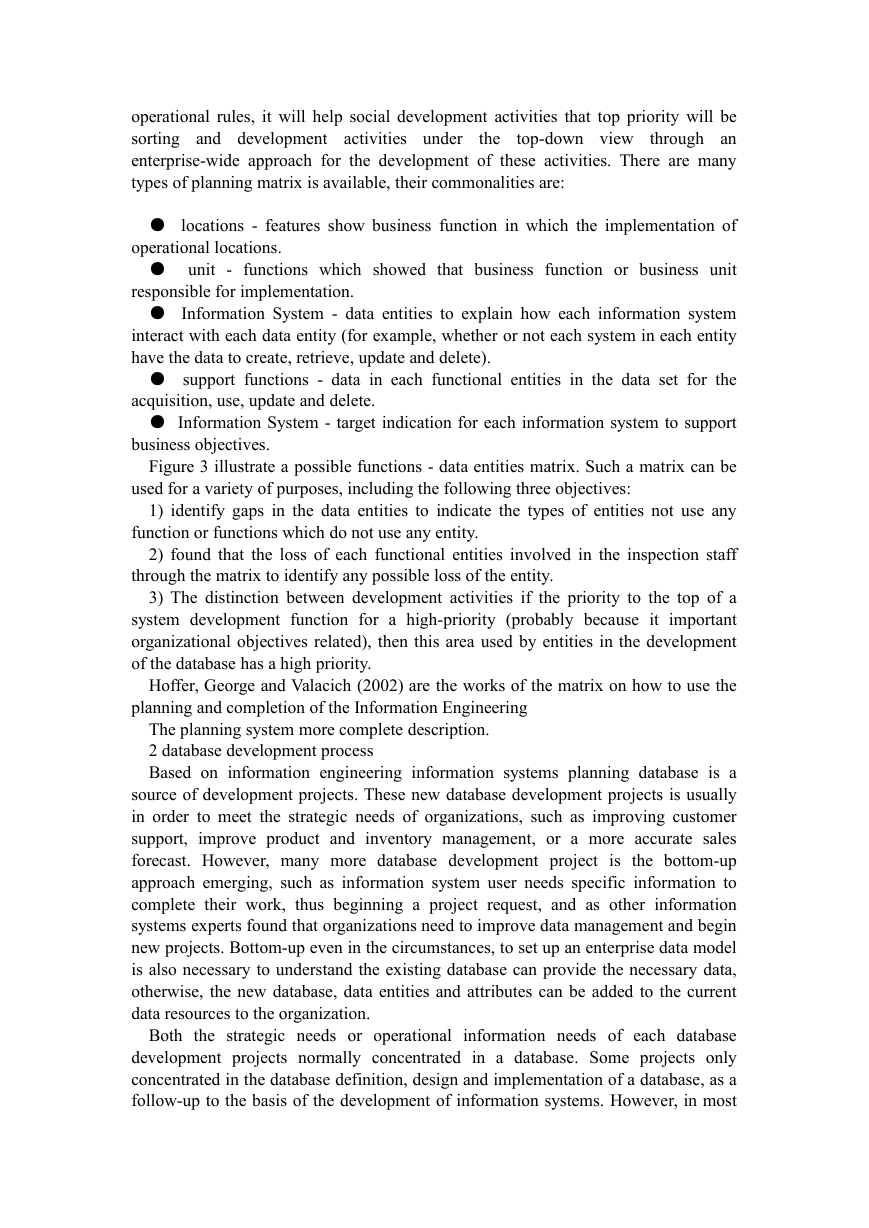
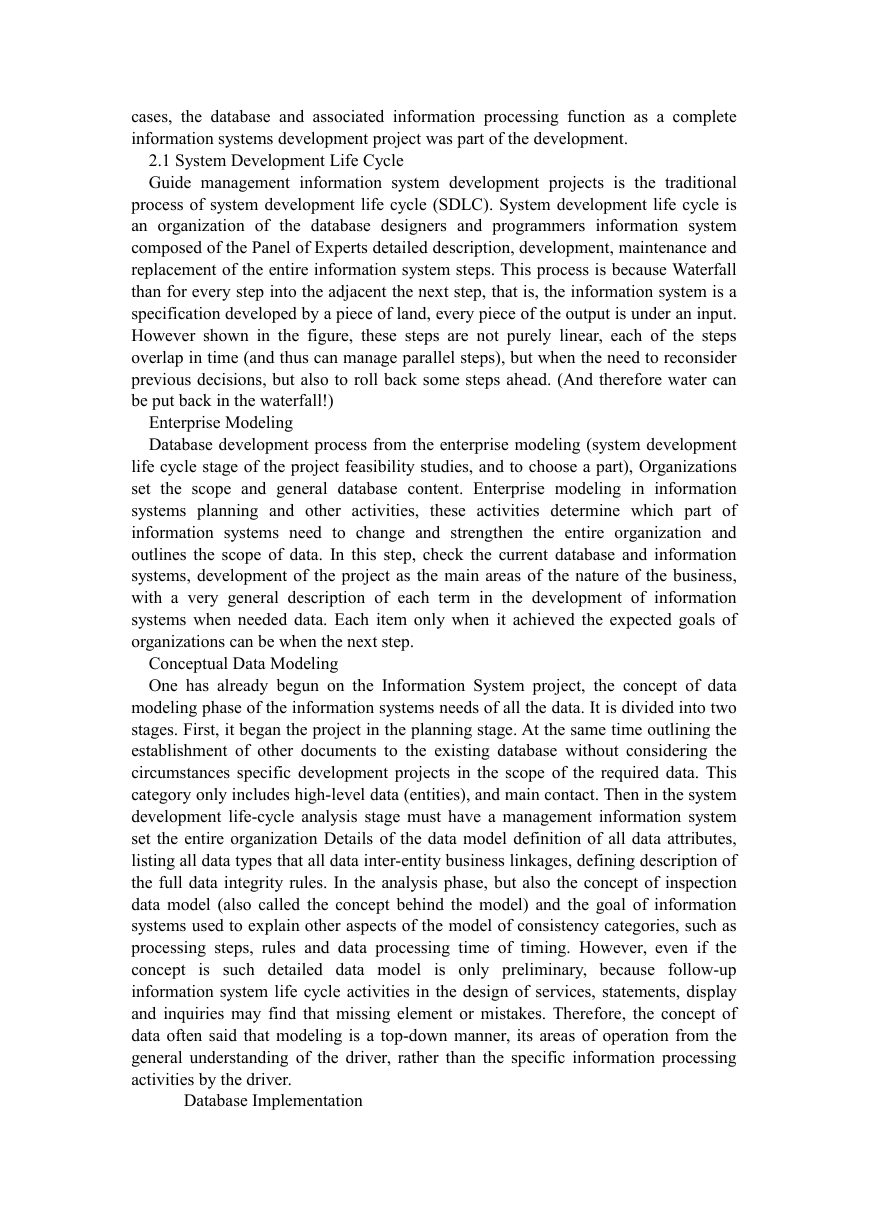
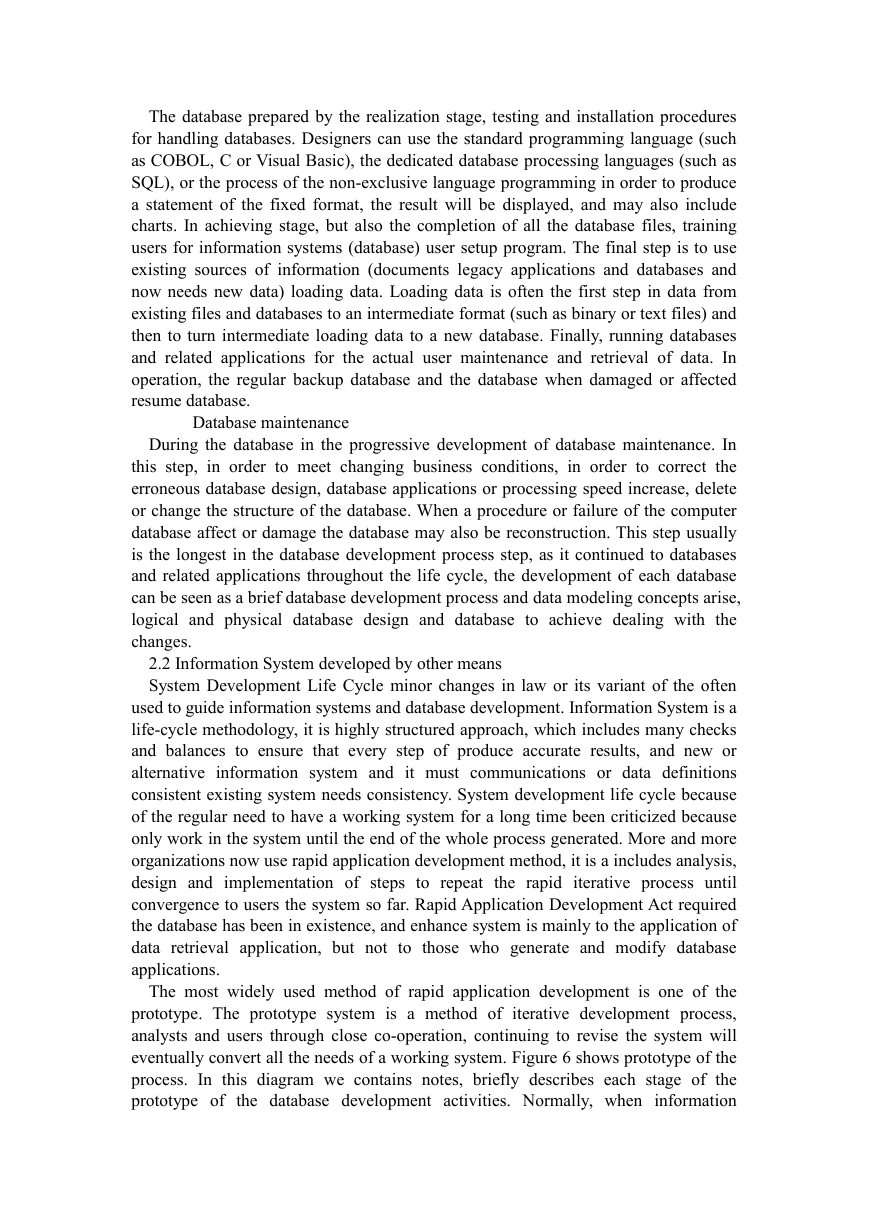
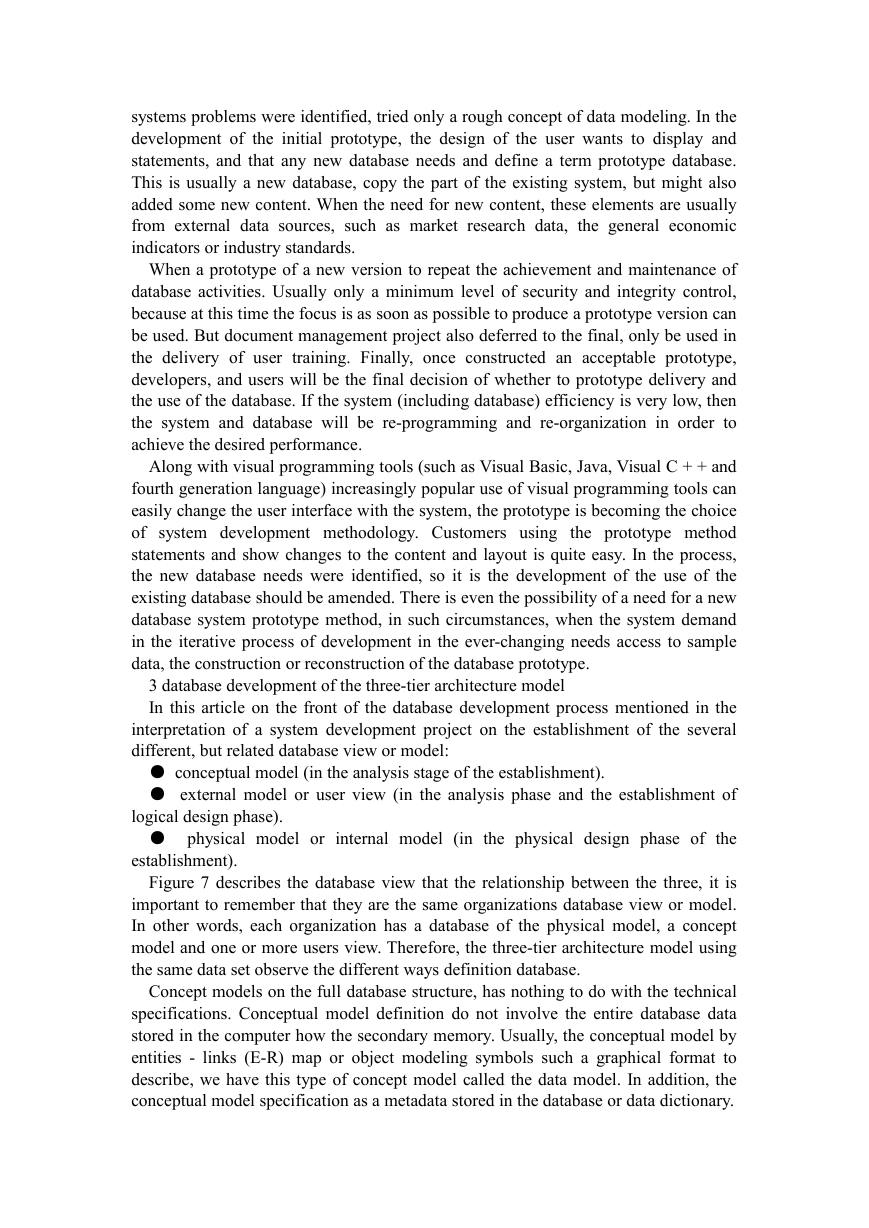
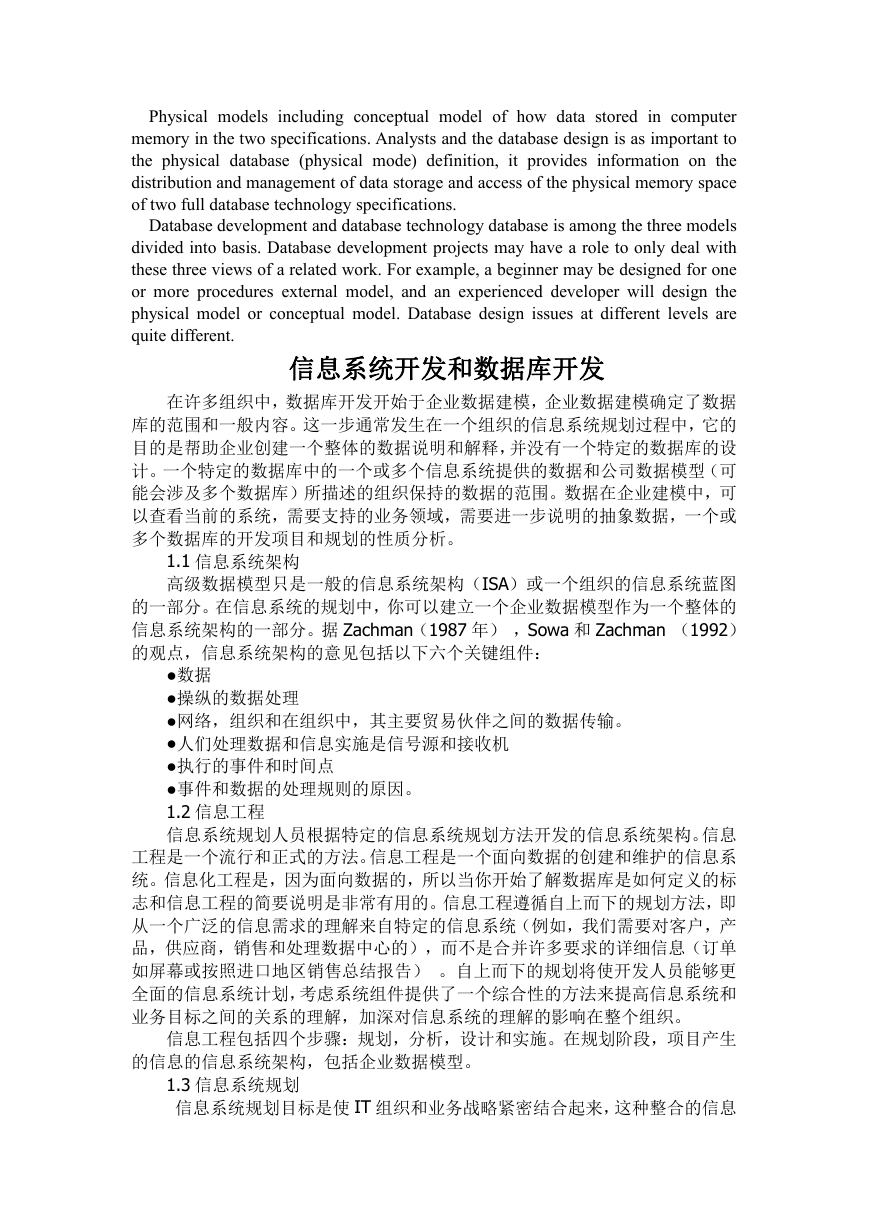









 2023年江西萍乡中考道德与法治真题及答案.doc
2023年江西萍乡中考道德与法治真题及答案.doc 2012年重庆南川中考生物真题及答案.doc
2012年重庆南川中考生物真题及答案.doc 2013年江西师范大学地理学综合及文艺理论基础考研真题.doc
2013年江西师范大学地理学综合及文艺理论基础考研真题.doc 2020年四川甘孜小升初语文真题及答案I卷.doc
2020年四川甘孜小升初语文真题及答案I卷.doc 2020年注册岩土工程师专业基础考试真题及答案.doc
2020年注册岩土工程师专业基础考试真题及答案.doc 2023-2024学年福建省厦门市九年级上学期数学月考试题及答案.doc
2023-2024学年福建省厦门市九年级上学期数学月考试题及答案.doc 2021-2022学年辽宁省沈阳市大东区九年级上学期语文期末试题及答案.doc
2021-2022学年辽宁省沈阳市大东区九年级上学期语文期末试题及答案.doc 2022-2023学年北京东城区初三第一学期物理期末试卷及答案.doc
2022-2023学年北京东城区初三第一学期物理期末试卷及答案.doc 2018上半年江西教师资格初中地理学科知识与教学能力真题及答案.doc
2018上半年江西教师资格初中地理学科知识与教学能力真题及答案.doc 2012年河北国家公务员申论考试真题及答案-省级.doc
2012年河北国家公务员申论考试真题及答案-省级.doc 2020-2021学年江苏省扬州市江都区邵樊片九年级上学期数学第一次质量检测试题及答案.doc
2020-2021学年江苏省扬州市江都区邵樊片九年级上学期数学第一次质量检测试题及答案.doc 2022下半年黑龙江教师资格证中学综合素质真题及答案.doc
2022下半年黑龙江教师资格证中学综合素质真题及答案.doc